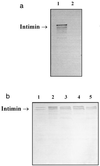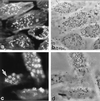Development of a universal intimin antiserum and PCR primers
- PMID: 10565891
- PMCID: PMC85821
- DOI: 10.1128/JCM.37.12.3822-3827.1999
Development of a universal intimin antiserum and PCR primers
Abstract
Enteropathogenic Escherichia coli (EPEC) and enterohemorrhagic E. coli (EHEC) constitute a significant risk to human health worldwide. A hallmark of both pathogens is their ability to produce characteristic attaching-and-effacing (A/E) lesions in intestinal epithelial cells. Genes encoding A/E lesion formation map to a chromosomal pathogenicity island termed the locus of enterocyte effacement (LEE). Intimin, an LEE-encoded bacterial adhesion molecule, mediates the intimate bacterium-host cell interaction characteristic of A/E lesions. On the basis of characterization of the C-terminal 280-amino-acid cell binding domain of intimin (Int280(661-939)), four distinct Int280 types (types alpha, beta, gamma, and delta) have been identified. Importantly, Int280alpha and Int280beta antisera specifically recognized their respective intimin types. Using a conserved region of the intimin molecule (Int(388-667)) and primers synthesized to generate the recombinant Int(388-667), we have now generated universal intimin antiserum and PCR primers that are reactive with the different intimin types expressed by both human and animal A/E lesion-forming strains. Use of immunogold electron microscopy to visualize intimin on the surfaces of EPEC and EHEC strains revealed, in general, a uniform distribution on the bacterial cell surface. However, a filamentous staining pattern was observed with a few strains expressing intimin gamma. Cloning of the intimin eae gene from one such strain (strain ICC57) into strain CVD206, an EPEC strain which harbors a null deletion in eae, produced a uniform intimin staining pattern indicating that, if the filamentous staining pattern defines a filamentous form of intimin gamma, it is dependent upon the genetic background of the strain and is not a feature of the intimin molecule.
Figures





References
-
- Albert M J, Faruque S M, Ansaruzzaman M, Islam M M, Haider K, Alam K, Kabir I, Robins-Browne R. Sharing of virulence-associated properties at the phenotypic and genetic levels between enteropathogenic Escherichia coli and Hafnia alvei. J Med Microbiol. 1992;37:310–314. - PubMed
-
- Cantey J R, Blake R K. Diarrhea due to Escherichia coli in the rabbit, a novel mechanism. J Infect Dis. 1977;135:454–462. - PubMed
-
- Donnenberg M S, Giron J A, Nataro J P, Kaper J B. A plasmid-encoded type IV fimbrial gene of enteropathogenic Escherichia coli associated with localized adherence. Mol Microbiol. 1992;6:3427–3437. - PubMed
Publication types
MeSH terms
Substances
Associated data
- Actions
Grants and funding
LinkOut - more resources
Full Text Sources
Other Literature Sources
Medical

